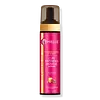What's inside
What's inside
 Key Ingredients
Key Ingredients

No key ingredients
 Benefits
Benefits

 Concerns
Concerns

 Ingredients Side-by-side
Ingredients Side-by-side

Water
Skin ConditioningChondrus Crispus Extract
Skin ConditioningAloe Barbadensis Leaf Juice
Skin ConditioningCocamidopropyl Dimethylamine Lactate
Propylene Glycol
HumectantVp/Dimethylaminoethylmethacrylate Copolymer
PEG-12 Dimethicone
Skin ConditioningDimethicone PEG-8 Meadowfoamate
EmollientPanthenol
Skin ConditioningGuar Hydroxypropyltrimonium Chloride
Skin ConditioningCocamidopropyl Betaine
CleansingPolysorbate 20
EmulsifyingMentha Piperita Oil
MaskingLactic Acid
BufferingParfum
MaskingWater, Chondrus Crispus Extract, Aloe Barbadensis Leaf Juice, Cocamidopropyl Dimethylamine Lactate, Propylene Glycol, Vp/Dimethylaminoethylmethacrylate Copolymer, PEG-12 Dimethicone, Dimethicone PEG-8 Meadowfoamate, Panthenol, Guar Hydroxypropyltrimonium Chloride, Cocamidopropyl Betaine, Polysorbate 20, Mentha Piperita Oil, Lactic Acid, Parfum
Water
Skin ConditioningDecyl Glucoside
CleansingPolyquaternium-55
Polysorbate 20
EmulsifyingPvp
Emulsion StabilisingMethyl Gluceth-20
HumectantPhenoxyethanol
PreservativeBenzoic Acid
MaskingEthylhexylglycerin
Skin ConditioningGlycereth-2 Cocoate
EmulsifyingOleth-20
CleansingHoney
HumectantAloe Barbadensis Leaf Juice
Skin ConditioningPunica Granatum Fruit Extract
AntioxidantPunica Granatum Seed Oil
EmollientPyrus Malus Fruit Extract
Skin ConditioningSimmondsia Chinensis Seed Oil
EmollientOrbignya Oleifera Seed Oil
EmollientButyrospermum Parkii Butter
Skin ConditioningSilk Amino Acids
HumectantPanthenol
Skin ConditioningQuaternium-75
Disodium EDTA
Tocopheryl Acetate
AntioxidantCitric Acid
BufferingParfum
MaskingWater, Decyl Glucoside, Polyquaternium-55, Polysorbate 20, Pvp, Methyl Gluceth-20, Phenoxyethanol, Benzoic Acid, Ethylhexylglycerin, Glycereth-2 Cocoate, Oleth-20, Honey, Aloe Barbadensis Leaf Juice, Punica Granatum Fruit Extract, Punica Granatum Seed Oil, Pyrus Malus Fruit Extract, Simmondsia Chinensis Seed Oil, Orbignya Oleifera Seed Oil, Butyrospermum Parkii Butter, Silk Amino Acids, Panthenol, Quaternium-75, Disodium EDTA, Tocopheryl Acetate, Citric Acid, Parfum
Ingredients Explained
These ingredients are found in both products.
Ingredients higher up in an ingredient list are typically present in a larger amount.
Aloe Barbadensis Leaf Juice comes from leaves of the aloe plant. Aloe Barbadensis Leaf Juice is best known for helping to soothe sunburns. It is also anti-inflammatory, moisturizing, antiseptic, and can help heal wounds.
Aloe is packed with good stuff including Vitamins A, C, and E. These vitamins are antioxidants, which help fight free-radicals and the damage they may cause. Free-radicals are molecules that may damage your skin cells, such as pollution.
Aloe Barbadensis Leaf Juice also contains sugars. These sugars come in the form of monosaccharides and polysaccharides, folic acid, and choline. These sugars are able to help bind moisture to skin.
It also contains minerals such as calcium, 12 anthraquinones, fatty acids, amino acids, and Vitamin B12.
Learn more about Aloe Barbadensis Leaf JuicePanthenol is a common ingredient that helps hydrate and soothe the skin. It is found naturally in our skin and hair.
There are two forms of panthenol: D and L.
D-panthenol is also known as dexpanthenol. Most cosmetics use dexpanthenol or a mixture of D and L-panthenol.
Panthenol is famous due to its ability to go deeper into the skin's layers. Using this ingredient has numerous pros (and no cons):
Like hyaluronic acid, panthenol is a humectant. Humectants are able to bind and hold large amounts of water to keep skin hydrated.
This ingredient works well for wound healing. It works by increasing tissue in the wound and helps close open wounds.
Once oxidized, panthenol converts to pantothenic acid. Panthothenic acid is found in all living cells.
This ingredient is also referred to as pro-vitamin B5.
Learn more about PanthenolParfum is a catch-all term for an ingredient or more that is used to give a scent to products.
Also called "fragrance", this ingredient can be a blend of hundreds of chemicals or plant oils. This means every product with "fragrance" or "parfum" in the ingredients list is a different mixture.
For instance, Habanolide is a proprietary trade name for a specific aroma chemical. When used as a fragrance ingredient in cosmetics, most aroma chemicals fall under the broad labeling category of “FRAGRANCE” or “PARFUM” according to EU and US regulations.
The term 'parfum' or 'fragrance' is not regulated in many countries. In many cases, it is up to the brand to define this term.
For instance, many brands choose to label themselves as "fragrance-free" because they are not using synthetic fragrances. However, their products may still contain ingredients such as essential oils that are considered a fragrance by INCI standards.
One example is Calendula flower extract. Calendula is an essential oil that still imparts a scent or 'fragrance'.
Depending on the blend, the ingredients in the mixture can cause allergies and sensitivities on the skin. Some ingredients that are known EU allergens include linalool and citronellol.
Parfum can also be used to mask or cover an unpleasant scent.
The bottom line is: not all fragrances/parfum/ingredients are created equally. If you are worried about fragrances, we recommend taking a closer look at an ingredient. And of course, we always recommend speaking with a professional.
Learn more about ParfumPolysorbate 20 is made by combining ethoxylation of sorbitan, ethylene oxide, and lauric acid. It is a mild cleansing agent, surfactant, and emulsifier.
As a surfactant, it helps collect dirt and oils for washing. Emulsifiers prevent oils and water from separating.
Polysorbate 20 also adds scent to a product. Since it is made using sorbitol, it has a sweet scent. Sorbitol can also be found in fruits such as apples and peaches.
The lauric acid used to create Polysorbate 20 is often derived from coconuts.
Polysorbate 20 may not be fungal acne safe.
Learn more about Polysorbate 20Water. It's the most common cosmetic ingredient of all. You'll usually see it at the top of ingredient lists, meaning that it makes up the largest part of the product.
So why is it so popular? Water most often acts as a solvent - this means that it helps dissolve other ingredients into the formulation.
You'll also recognize water as that liquid we all need to stay alive. If you see this, drink a glass of water. Stay hydrated!
Learn more about Water